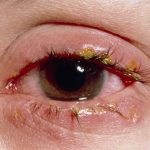 Inflammation of the eyelids, characterized by redness, swelling, and dried crusts of mucus and caused by infection, allergic reaction, or other factors.
Inflammation of the eyelids, characterized by redness, swelling, and dried crusts of mucus and caused by infection, allergic reaction, or other factors.
Inflammation of the edges of the eyelids. The eyelids look sticky, crusty, and reddened, with scales that cling to the bases of the lashes. The eye may feel gritty when blinking and itch or burn. Eyelashes can fall out. Blepharitis has a number of possible causes, including bacterial infection, lice in the eyelashes, or a skin condition known as seborrheic dermatitis, which causes scaling and yellow crusty patches and appears on other parts of the body besides the eyelids, particularly the scalp. The lining of the eye may also become infected, resulting in conjunctivitis (pinkeye). In rare instances of severe infection, the clear outer covering of the eye (cornea) can ulcerate. In most cases, blepharitis does not threaten sight. Crusts are removed by cleaning the eyelids with a clean cloth soaked in warm water; mild baby shampoo can also be used. Antibiotic or corticosteroid ointments may also be prescribed to f ight infection and reduce swelling. If lice are present, they can be eradicated by placing petroleum jelly on the base of the eyelashes.
Inflammation of the eyelids. In squamous blepharitis, often associated with dandruff of the scalp, white scales accumulate among the lashes. Chronic ulcerative blepharitis is characterized by yellow crusts overlying ulcers of the lid margins. The lashes become matted together and tend to fall out or become distorted. Allergic blepharitis may occur in response to drugs or cosmetics put in the eye or on the eyelids.
Ulcerative or nonulcerative inflammation of the hair follicles and glands along the edges of the eyelids.
Blepharitis is characterized by the inflammation of the eyelids, accompanied by redness, irritation, and scaly skin at the margins of the lids. This condition can cause a burning sensation, discomfort in the eyes, and the presence of flakes or crusts on the eyelashes. Blepharitis is a common ailment that tends to recur and is occasionally associated with dandruff of the scalp or eczema. In severe cases, it can lead to corneal ulcers. Many instances of blepharitis can be improved by treating the associated dandruff with an antifungal shampoo.
Swelling along the edges of the eyelids can occur, particularly in children who are in poor health due to substandard living conditions. This condition is sometimes linked to seborrhea of the scalp, which causes dandruff. The dandruff can then lead to infection of the eyelids.
